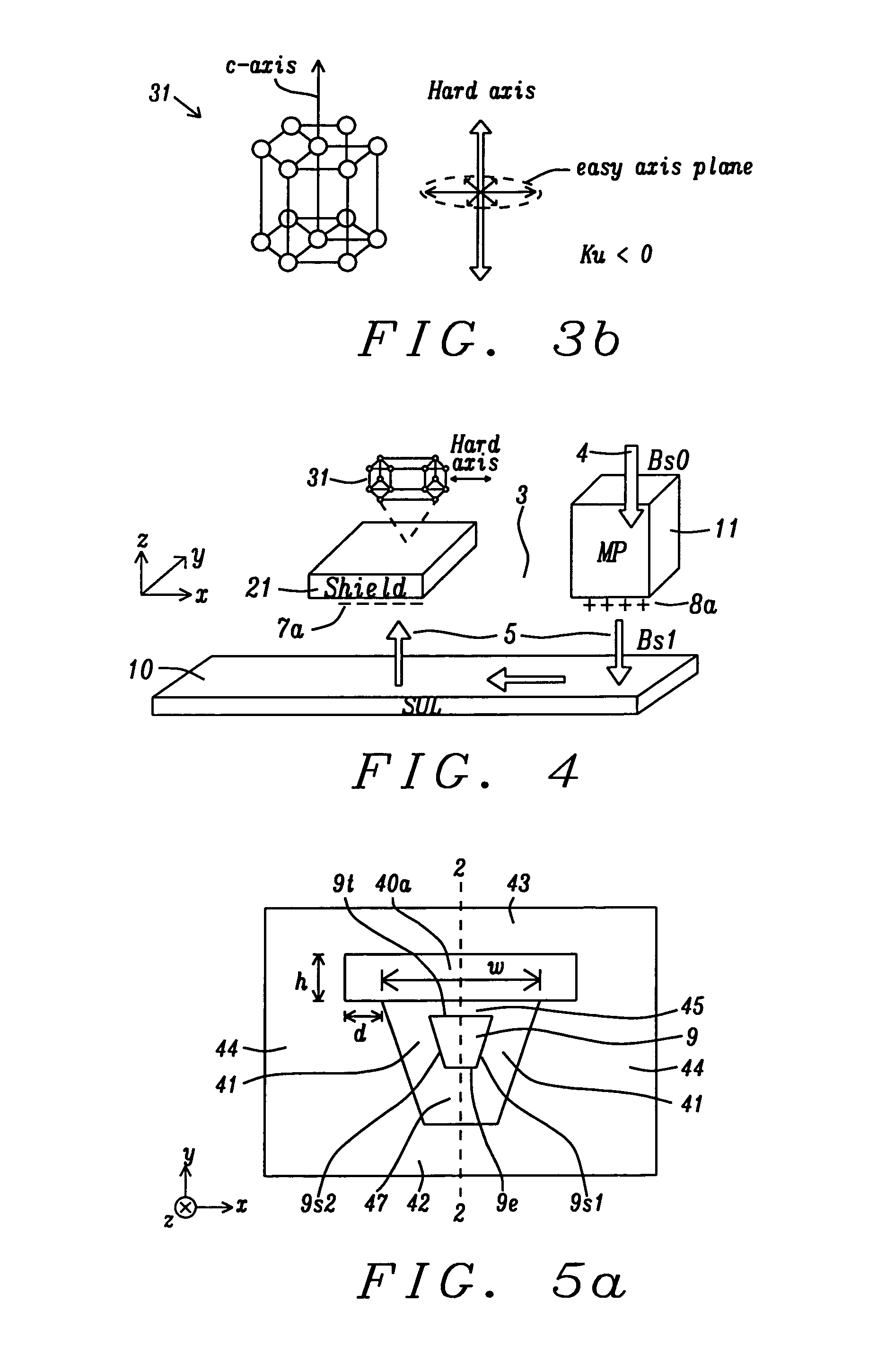PMR write head with narrow gap for minimal internal flux loss
a technology of internal flux loss and write head, which is applied in the field of magnetic shield material, can solve the problem of insignificant flux loss from the main pole to the shield, and achieve the effect of improving field gradient, low internal flux loss, and low cos
- Summary
- Abstract
- Description
- Claims
- Application Information
AI Technical Summary
Benefits of technology
Problems solved by technology
Method used
Image
Examples
first embodiment
[0038]Referring to FIG. 4, the present invention is shown wherein a shield 21 made of an anisotropic (-Ku) magnetic material with a plurality of crystals 31 and a hard axis in the x-axis direction is advantageously used to prevent flux leakage from a main pole 11 formed in a x-axis direction from the shield 21 and separated therefrom by gap 3. By depositing the shield layer on an appropriate seed layer (not shown), the c-axis of each hexagon crystal 31 is pointing toward the main pole. Magnetic charges 7a are still generated at the ABS of the shield 21 during a write process to facilitate the desired flow 5 of flux from the main pole 11 into the magnetic medium 10, and then into the shield 21. The magnetization direction of the shield 21 may be induced orthogonal to the hard axis by a weak magnetic field which has a magnitude less than about 20 Oe.
second embodiment
[0039]Referring to FIG. 5a, the present invention is shown from an ABS view and includes a main pole 9 having a trapezoidal shape with a leading edge 9e that has a smaller width in a cross-track (x-axis) direction than the trailing edge 9t. Sloped sides 9s1, 9s2 of the main pole are adjoined by a side gap 41 made of a dielectric material. Main pole 9 may include a seed layer (not shown) along sides 9s1, 9s2 and along leading edge 9e that facilitates a deposition method wherein main pole material is plated in an opening bounded by side gaps 41 and lead gap 47. In the exemplary embodiment, the side gap has a uniform width in the x-axis direction and conforms to the shape of the sides 9s1, 9s2. There is also a write gap 45 having a width w that adjoins a top surface of each side gap 41 and interfaces with the trailing edge 9t of the write pole. The write gap may be comprised of the same dielectric material as in the side gap. A leading gap 47 interfaces with the leading edge 9e and adj...
fifth embodiment
[0049]The fifth embodiment also anticipates that a non-magnetic metal layer 65 made of Ru, for example, may be formed between each first shield section and an adjacent second shield section to prevent interlayer coupling between first and second shield sections. Thus, the non-magnetic metal layer 65 forms a contiguous layer and separates first trailing shield section 40a from second trailing shield section 43, first side shield section 40b (and 40d) from a second side shield section 44, and first leading shield section 40c from second leading shield section 42. A method of forming the shield structure in FIG. 8 is not provided here. However, a combination of fabrication processes described with regard to FIGS. 9-16 may be employed to make the AWA shield structure where there is a contiguous anisotropic (-Ku) magnetic shield layer surrounding the main pole as appreciated by those skilled in the art.
[0050]Referring to FIG. 9, an intermediate structure formed during the fabrication of ...
PUM
| Property | Measurement | Unit |
|---|---|---|
| thickness | aaaaa | aaaaa |
| thickness | aaaaa | aaaaa |
| angle | aaaaa | aaaaa |
Abstract
Description
Claims
Application Information
 Login to View More
Login to View More - R&D
- Intellectual Property
- Life Sciences
- Materials
- Tech Scout
- Unparalleled Data Quality
- Higher Quality Content
- 60% Fewer Hallucinations
Browse by: Latest US Patents, China's latest patents, Technical Efficacy Thesaurus, Application Domain, Technology Topic, Popular Technical Reports.
© 2025 PatSnap. All rights reserved.Legal|Privacy policy|Modern Slavery Act Transparency Statement|Sitemap|About US| Contact US: help@patsnap.com



